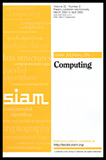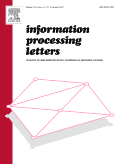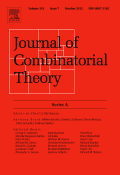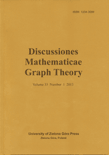
Advances and Applications in Discrete Mathematics
Scope & Guideline
Unlocking Potential in Combinatorics, Graph Theory, and Algorithms
Introduction
Aims and Scopes
- Graph Theory and Its Applications:
The journal extensively covers topics related to graph theory, including domination numbers, neighborhood polynomials, and various graph operations. This area emphasizes both theoretical advancements and practical applications in computer science, network analysis, and other fields. - Combinatorial Mathematics:
Research in combinatorial mathematics is a significant focus, exploring counting techniques, polynomial representations, and combinatorial structures. This includes studies on cliques, independent sets, and graph labeling, which are critical for optimization problems in various scientific fields. - Mathematical Modeling and Analysis:
The journal publishes works that apply discrete mathematics to model and analyze real-world scenarios, such as in engineering, economics, and computer science. This includes topics such as optimization problems, resource allocation, and dynamic systems. - Cryptography and Information Security:
With the increasing importance of data security, the journal includes research on cryptographic protocols, secure communication methods, and applications of algebraic structures in cryptography, highlighting the intersection of discrete mathematics and cybersecurity. - Computational Techniques in Discrete Mathematics:
The journal features studies that employ computational methods, including algorithms and machine learning approaches, to solve complex problems in discrete mathematics. This includes the use of deep learning for applications like malware detection and crop disease monitoring.
Trending and Emerging
- Machine Learning Applications in Discrete Mathematics:
There is a growing trend towards integrating machine learning techniques with discrete mathematics, particularly in applications such as crop disease detection and malware identification. This intersection is proving to be a rich area for exploration and innovation. - Applications of Graph Theory in Network Science:
Recent publications have increasingly focused on the application of graph theory to network science, including social networks and communication networks. This trend highlights the relevance of discrete mathematics in understanding complex systems and interactions. - Interdisciplinary Approaches:
Research that combines discrete mathematics with other fields, such as biology, economics, and engineering, is on the rise. This interdisciplinary approach is fostering innovative solutions to complex problems and expanding the applicability of discrete mathematical concepts. - Advanced Computational Algorithms:
The development and analysis of advanced computational algorithms for solving discrete mathematical problems are becoming more prominent. This includes algorithmic studies for optimization and resource allocation, reflecting a demand for efficient solutions in various applications.
Declining or Waning
- Classical Graph Labeling Techniques:
Traditional graph labeling techniques, such as graceful labeling and cordial labeling, have seen a reduction in new contributions. This may indicate a saturation point in this area, with researchers moving towards more complex or applied forms of graph theory. - Static Graph Properties:
Research focusing solely on static properties of graphs, such as chromatic numbers and degree sequences, appears to be declining. The trend suggests a shift towards dynamic and algorithmic approaches that consider graph evolution and real-time applications. - Basic Combinatorial Structures:
There has been a noticeable decrease in publications centered around elementary combinatorial structures, like basic permutations and combinations, as researchers increasingly focus on more intricate combinatorial problems that have direct applications or implications.
Similar Journals

SIAM JOURNAL ON COMPUTING
Fostering Excellence in Computational Research and Methodologies.Welcome to the SIAM Journal on Computing, a premier publication of SIAM Publications dedicated to advancing the field of computational science. Established in 1984, this journal provides a platform for groundbreaking research and theoretical advancements that shape the landscape of both Computer Science and Mathematics. With an impressive impact factor and consistently ranking in Q1 quartiles for its categories, the journal remains an essential resource for scholars looking to contribute to innovative computational theories and methodologies. Although not currently an open-access journal, the SIAM Journal on Computing offers rigorous peer-reviewed articles, ensuring high-quality contributions that appeal to researchers, professionals, and students alike. As we converge towards 2024, this journal continues to play a vital role in influencing future research directions and fostering an academic community devoted to the exploration of computational challenges. Join us in exploring the forefront of computing research!

Applicable Analysis and Discrete Mathematics
Pioneering Discoveries in Applied Analysis and Discrete TheoryApplicable Analysis and Discrete Mathematics is a prestigious academic journal dedicated to the fields of analysis, applied mathematics, and discrete mathematics. Published by the esteemed University of Belgrade, Faculty of Electrical Engineering, this journal has established itself as a vital resource for researchers, professionals, and students alike, with a strong focus on advancing theoretical and practical knowledge in these disciplines. As of 2023, it holds a commendable ranking in the Q2 quartile across multiple categories including Analysis, Applied Mathematics, and Discrete Mathematics and Combinatorics, reflecting its significant impact and relevance in the academic community, with Scopus rankings placing it in the top 25% for Discrete Mathematics and Combinatorics. Although currently not an open-access journal, it strives to provide a platform for high-quality original research articles and discussions that bridge theoretical insights and real-world applications. Since its inception in 2007 and set to continue through 2024, the journal remains committed to fostering innovation and collaboration within the mathematical sciences.

Journal of Mathematics in Industry
Advancing Industry through Mathematical ExcellenceJournal of Mathematics in Industry, published by Springer, stands as a pivotal platform for researchers and professionals exploring the intersection of mathematical applications and real-world industrial challenges. With an impact factor signaling its robust influence in the field, the journal has distinguished itself within the Q3 quartile of applied mathematics, ranking 95 out of 635 according to Scopus, placing it in the 85th percentile among its peers. Since its inception in 2011, the journal has embraced the Open Access model, fostering a collaborative and unrestricted dissemination of knowledge. This initiative not only enhances visibility but also encourages engagement from a global audience eager to apply mathematical innovations in various industries. As the journal looks towards the future, it continues to bridge the gap between theoretical mathematical research and practical industrial applications, making it an invaluable resource for academics, practitioners, and students alike.

International Journal of Mathematics and Computer Science
Navigating the Complexities of Mathematics and ComputingThe International Journal of Mathematics and Computer Science (ISSN: 1814-0424, E-ISSN: 1814-0432), published by Lebanese University, serves as a vital platform for disseminating innovative research and advancements in the fields of mathematics and computer science. With a compelling range of topics including Algebra, Applied Mathematics, Computational Mathematics, and Statistical Analysis, this journal caters to a broad audience of researchers, professionals, and students. Spanning the years from 2017 to 2025, it has established a presence in several key quartiles, including Q3 rankings in Applied Mathematics and Computational Mathematics, and a Q4 ranking in Algebra and Number Theory. While currently not an open-access journal, it provides valuable insights through its rigorous peer-reviewed process, enhancing its relevance in both theoretical and applied domains. Furthermore, its presence in Scopus rankings reflects its commitment to quality, making it an essential resource for anyone looking to explore the intersection of mathematics and computer science.

INFORMATION PROCESSING LETTERS
Connecting Scholars through Rigorous ResearchINFORMATION PROCESSING LETTERS, published by ELSEVIER and with an ISSN of 0020-0190, is a prominent academic journal that serves as a vital resource in the fields of Computer Science, Information Systems, and Signal Processing, among others. As evidenced by its Q3 ranking across various categories in 2023, including Computer Science Applications and Theoretical Computer Science, it provides a rigorous platform for the dissemination of innovative research and theoretical developments. Researchers and professionals can delve into a wide array of subjects pertinent to information processing, contributing to advancements in technology and data management. Although it does not offer Open Access options, the journal maintains an influential presence in scholarly discourse, making it a crucial reference for those engaged in computational innovations and system optimizations. With coverage from 1971 to 2025, it continues to be integral for both seasoned academics and emerging scholars.

JOURNAL OF COMBINATORIAL THEORY SERIES A
Pioneering Research in Combinatorial Structures and Algorithms.JOURNAL OF COMBINATORIAL THEORY SERIES A, published by Academic Press Inc. Elsevier Science, stands as a pivotal platform for researchers in the realm of combinatorial mathematics and theoretical computer science. With an impact factor that underscores its influence and a well-respected reputation reflected in its rapid ascent to Q1 rankings in discrete mathematics and computational theory, this journal serves as a critical resource for academics seeking to advance their understanding of complex combinatorial structures and algorithms.
Founded in 1971, the journal covers a wide spectrum of topics within combinatorial theory, providing a robust forum for innovative research and theoretical advancements until 2025. Including a strong position in the Scopus rankings—notably, it ranks #10 out of 92 in discrete mathematics—the journal is essential for both emerging scholars and established professionals committed to pushing the boundaries of mathematical and computational inquiry. Researchers are encouraged to submit their findings to this esteemed publication, as it offers a non-open-access model that ensures rigorous peer review and high visibility within the academic community.

Discussiones Mathematicae Graph Theory
Connecting Researchers Through Graph Theory InsightsDiscussiones Mathematicae Graph Theory is a prestigious peer-reviewed journal published by UNIV ZIELONA GORA, specializing in the dynamic fields of Graph Theory, Discrete Mathematics, and Applied Mathematics. With an ISSN of 1234-3099 and an E-ISSN of 2083-5892, this Open Access journal has been providing unrestricted access to its content since 2013, promoting widespread dissemination and engagement in academic research. Established in 2009 and continuing its influential publication through 2024, Discussiones Mathematicae Graph Theory is committed to fostering collaborations and innovations among researchers, professionals, and students alike. Its impressive category quartiles for 2023 show it ranks within the Q3 range for both Applied Mathematics and Discrete Mathematics and Combinatorics, as well as good positions within the Scopus rankings, ensuring its critical relevance in the mathematical community. By continuously highlighting groundbreaking research in graph theory, this journal stands as a vital resource for anyone looking to advance their knowledge and contribute to the evolving landscape of mathematics.

JOURNAL OF COMBINATORIAL OPTIMIZATION
Fostering breakthroughs in algorithm development and analysis.JOURNAL OF COMBINATORIAL OPTIMIZATION, published by Springer, stands at the forefront of research in the fields of applied mathematics, computational theory, and combinatorial optimization. With an ISSN of 1382-6905 and E-ISSN of 1573-2886, this esteemed journal serves as a vital platform for groundbreaking studies and methodologies from 1997 to 2024. Notably positioned in the Q3 quartile across several categories, including applied mathematics and discrete mathematics, it reflects a commitment to high-quality research that pushes the boundaries of knowledge in quantitative analysis and algorithm development. Although it does not offer open access, its visibility and impact are underscored by impressive Scopus rankings, such as the 67th percentile in discrete mathematics and combinatorics. The journal aims to foster a comprehensive understanding of combinatorial optimization and its applications, making it an indispensable resource for researchers, professionals, and students eager to stay abreast of the latest trends and advancements in these dynamic disciplines.

DISCRETE MATHEMATICS
Illuminating the path for future mathematical innovations.DISCRETE MATHEMATICS, published by Elsevier, is a leading journal dedicated to the field of discrete mathematics and combinatorics, with a distinguished presence in the academic community since its inception in 1971. With an ISSN of 0012-365X and an E-ISSN of 1872-681X, this esteemed journal has firmly established itself within the Q1 category for Discrete Mathematics and Combinatorics, and Q2 for Theoretical Computer Science as per the 2023 metrics, underscoring its pivotal role in advancing research in these vital areas. DISCRETE MATHEMATICS is highly regarded, reflected in its Scopus rankings, where it stands at #44 out of 92 in its primary category, contributing significantly to the global discourse on complex mathematical theories and applications. Published from the Netherlands, the journal serves as a crucial resource for researchers, professionals, and students looking to stay informed about the latest innovations and methodologies in discrete mathematics. Though currently not an open-access journal, DISCRETE MATHEMATICS continues to foster a vibrant scholarly community through rigorous peer-reviewed research, promoting a deeper understanding of the mathematical structures that underpin both theoretical and applied science.

Punjab University Journal of Mathematics
Nurturing a community of mathematical thinkers and innovators.Punjab University Journal of Mathematics is a prestigious academic journal published by the Department of Mathematics at the University of Punjab, Pakistan. Dedicated to advancing the field of mathematics, this journal provides a platform for researchers, educators, and students to disseminate their findings, foster scholarly dialogue, and promote innovative mathematical research. With a strong focus on theoretical and applied mathematics, the journal maintains a rigorous peer-review process to ensure high-quality publications that significantly contribute to the mathematical community. Although currently not indexed in prominent databases, the journal aims to elevate its visibility and impact through consistent publication of cutting-edge research. The absence of Open Access reflects a commitment to quality and thorough review, but researchers are encouraged to seek out this valuable resource for its insights and diverse contributions to mathematics.